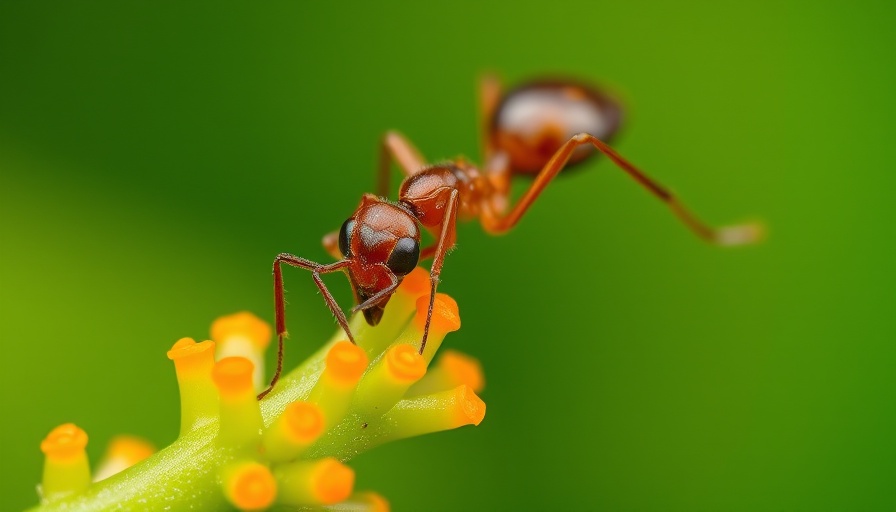
Understanding Ants: Nature's Unseen Players in Our Homes
In Marin County, where the seasons can bring unexpected weather, many of us are familiar with discovering trails of ants in our kitchens. These determined little creatures come indoors seeking refuge from the elements or looking for food. The two most common species in our area are the Argentine ant and the carpenter ant, among the estimated 270 species found in California. While ants play crucial roles in our ecosystems outdoors, their presence in our homes can quickly become a nuisance.
Recognizing Infestation Signs Early
Being proactive in identifying ant infestations is critical. Argentine ants, identifiable by their small, dark brown bodies and complex nest structures, often lay hidden in damp areas close to food sources. Signs to watch for include visible trails along countertops or floors, the presence of the ants themselves around food or water, and the subtle yet distinct trails they leave behind. If your home is invaded, it’s essential to act swiftly to mitigate their spread.
Effective Strategies to Eliminate Indoor Ants
As anyone who has faced an ant invasion knows, removing their food source is paramount. Start by keeping your kitchen spotless—mopping floors, sealing food in airtight containers, and promptly cleaning spills can help deter these pests. Vacuuming ant trails or using soapy water can eliminate both the ants and their pheromone scents that attract more.
Inspecting your home for entry points is also crucial. Small cracks around windows, doors, and foundations can serve as gateways for an ant invasion. Seal these openings with caulk or even petroleum jelly to block their access. It’s worth noting that while insecticides can be effective, they don’t necessarily address the root of the problem—an entire colony often linked through elaborate trail systems.
Outside Measures to Prevent Ants
Prevention is key when it comes to outdoor ant management. To keep ants from moving indoors, it’s wise to clear debris and vegetation around your home's foundation. This minimizes potential nesting sites and deprives ants of food sources, particularly aphids, which they tend to protect for their honeydew secretion. Consider deploying slow-acting bait outside; while it may take days before the workers transport it back to their colonies, it offers a long-term solution to an infestation.
Professional Aid: When It’s Time to Call for Help
Sometimes, despite our best efforts, ant infestations persist. That’s when professional pest control comes into play. Experts can provide thorough inspections, tailored strategies, and the eviction of entire colonies instead of merely warding off individual foraging ants. Pest management professionals are equipped with advanced tools and techniques designed to eliminate the complex ant matriarchies that lurk in our homes.
Beyond Pests: Understanding the Ant Ecosystem
The interaction of ants with the environment is fascinating. Though ants can be viewed as mere pests within our homes, they fulfill essential ecological functions outdoors, such as nutrient recycling and soil aeration. Their aggressive behavior helps control pest populations by feeding on insects like fleas and termites. Recognizing their dual role in our environment can lead to more informed approaches to managing their activity without resorting to overly harmful measures.
Future Insights: The Emerging Landscape of Ant Control
Researchers continue to study ant behavior and control methods to find more effective ways of addressing infestations as houses become increasingly integrated with natural habitats. Innovations in pest management often involve combination strategies—utilizing both baiting methods and preventive measures tailored to specific environments. With ongoing research, homeowners can look forward to safer and more efficient methods for handling their ant challenges.
Actionable Insights: Steps for the Homeowner
To combat ant infestations effectively, remember these actionable tips:
- Maintain a clean home, free from crumbs and spills.
- Seal entry points and create a barrier around your property.
- Utilize slow-acting baits strategically both indoors and outdoors.
- Consult a pest management professional when necessary.
By implementing these strategies, residents of Marin County can reclaim their homes from unwanted ant invasions and maintain a healthier living environment.
For more detailed guidance or immediate assistance, don’t hesitate to contact local pest control services tailored to your needs. Taking proactive measures today can lead to significant long-term relief from these tiny invaders.
 Add Row
Add Row  Add
Add 




 Add Row
Add Row  Add
Add 

Write A Comment